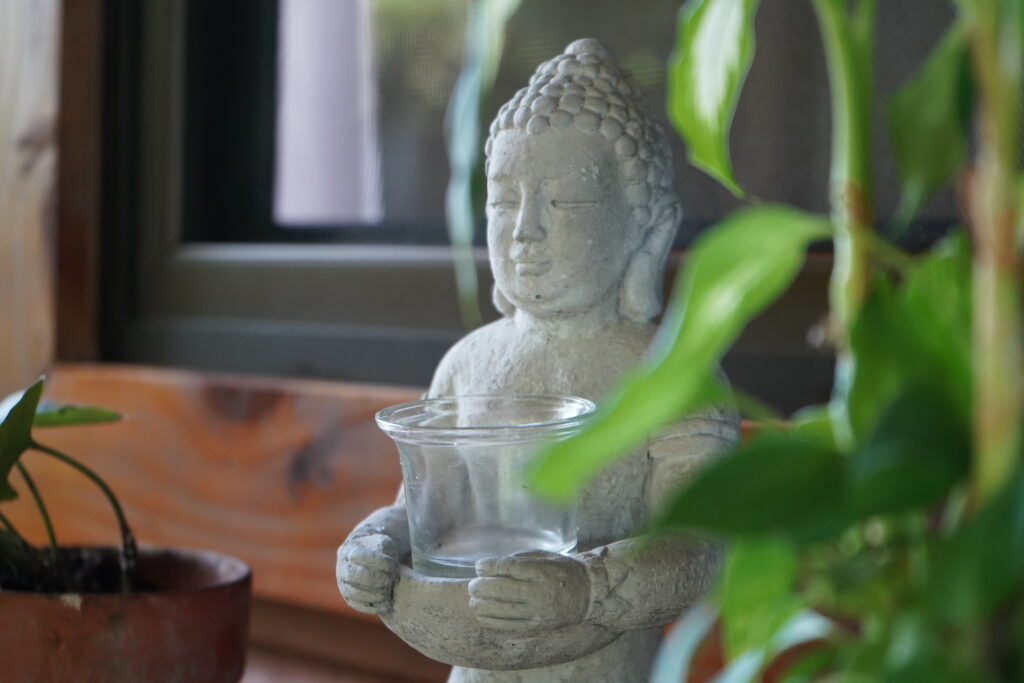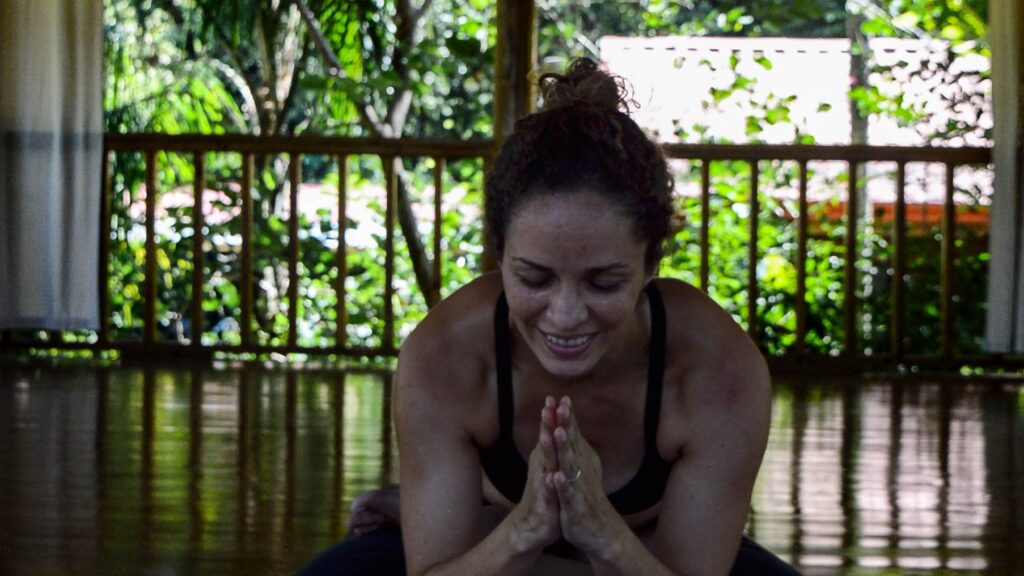Yoga is one of the few types of exercise that actually helps improve balance. It combines physical postures and mental focus to maintain an even weight distribution, keeping ourselves upright and steady. This strengthens all those tiny little muscles and tendons in our feet, ankles, knees, and hips. But yoga also allows us to find more spiritual balance by helping us find equilibrium with our thoughts and emotions.
The significance of physical, mental, and emotional balance
These two benefits (mental and physical) of a balance-focused yoga routine have served me greatly in my life. Since I have been practicing yoga for 12 years, when I pick up new hobbies, I have no problem translating the skills I’ve learned on the mat to new areas of physical ability.
Even though I was a beginner, when I started rock climbing, the movements came quickly and naturally. Because of a sound yoga practice, I could hold steady to a tiny rock grip 30 feet up a wall, balancing on the big toe of my left foot without breaking a sweat.
Likewise, when I began sailing a small, single-handed boat called a “laser” as a hobby at UCLA’s Marina Aquatic Center in Marina Del Rey, I breezed past the beginner courses and soon worked as a second sail instructor. The laser, by the way, is a simple yet high-performance dinghy in which the balancing of the crew’s weight is a critical component of the operation. Thanks to yoga, I naturally balanced my weight on the boat based on pure intuition.

Surfing is no different- it’s an activity that, at its most fundamental, is a balancing act. Surfers sit, lay, kneel, drop-knee (Travis), and stand on a thin piece of floating foam rising and falling with the ocean’s whims. Many beginners are surprised by the fact that even sitting upright on a surfboard can be a great challenge for one’s balance, which engages the core and arms to counteract the shifting plank of foam.
In fact, life itself is a balancing act, and improving one’s mental balance is crucial to building resiliency and the ability to adapt to new situations. As a surfer living in Phoenix, Arizona, I’m constantly asked, “How can you cope without surfing?” But for me, the answer is simple. “Yoga,” I respond.
Understanding Balance in Yoga
The sixth limb of Yoga, Dhāraṇā, is the concentration of the mind. In Yoga, we often focus the mind on the breath, deep inhales, and long, slow exhales. But we can also focus on a Drishti, or a focal point meant for gazing during the yoga practice. By focusing the eyes on a fixed point, such as the tip of the fingers, we turn our attention inwards, moving into a deeper state of meditation.
Fixing the gaze and concentrating the mind also improves one’s physical balance by helping to align the eyes, head, and spine, enhancing the alignment of the entire body. Proper alignment improves one’s proprioception (sense of body in space) and allows us to make minor adjustments to maintain our balance.
My yoga teacher always says, “Little movements keep you there.”

There are 9 Drishtis, or fixed focal points:
- Nasagra Drishti: Gazing at the tip of the nose. This is commonly used in many seated or standing poses.
- Ajna Chakra Drishti: Focusing the gaze between the eyebrows, also known as the “third eye.” This is often used in meditation and balancing poses.
- Hastagrahi Drishti: Gazing at the hand. It is used when the hands are extended or reaching out in various poses.
- Pahayoragrai Drishti: Gazing at the toes. It is used in standing forward bends and other poses where the feet are in focus.
- Parsva Drishti: Gazing to the left or right. This is used in twisting poses and lateral stretches.
- Angusthamadhye Drishti: Gazing at the thumbs. It is used in hand mudras or specific hand positions.
- Urdhva Drishti: Gazing upwards. This is often used in backbends and uplifting poses.
- Nabi Chakra Drishti: Gazing at the navel. It is used in poses where the belly region is engaged or in focus.
- Padayoragrai Drishti: Gazing at the feet. This is used in poses where the feet play a significant role, such as balancing postures.
The following ten yoga poses will not only help you feel more stable in your body and in life but will serve to strengthen your core, abdomen, and lower back. They will increase the flexibility of the muscles and joints, making it easier to make those minute adjustments to keep your balance. They will also encourage body awareness, helping your mind to become attuned to the subtle shifts in weight and movement in your form. Finally, yoga is a mindfulness practice that helps us cultivate concentration and present-moment awareness- skills that will serve you on and off the mat. Namaste.
10 Yoga Poses to Improve Balance

1. Mountain Pose (Tadasana)
Try it: Stand tall with your feet hip-width apart and your toes pointing forward. Distribute your weight evenly on both feet, engaging the leg muscles and lifting your kneecaps. Lengthen your spine, tuck your tailbone slightly, and draw your shoulder blades back and down. Relax your arms by your sides, with palms facing forward. Direct your gaze inwards by closing your eyes, feel your weight shifting between the four corners of your feet, and breathe deeply.
Balance Benefits: Mountain pose is the foundation for all standing poses. It improves overall posture, aligns the body, and develops body awareness. Focus on evenly distributing weight between both feet, grounding through the feet, and engaging core muscles for better balance. Close your eyes for an added challenge.
2. Tree Pose (Vrikshasana)
Try it: Start in Tadasana. Shift your weight onto one foot and bend your opposite knee.
Place the sole of your bent foot on the standing leg’s inner thigh, calf, or ankle. Find your balance, pressing the foot into the leg and the leg into the foot. Bring your hands to a prayer position at your heart or extend them overhead for an additional shoulder stretch and challenge. Gaze softly at a fixed point to focus your attention on your body alignment.
Balance Benefits: Tree pose improves concentration, focus, and balance. It strengthens the muscles in the standing leg and works on proprioception—the sense of where your body is in space. Closing your eyes will make any balancing pose harder.

3. Warrior II (Virabhadrasana II)
Try it: Start in a standing position with feet wide apart, about 3-4 feet distance. Turn your right foot out 90 degrees and your left foot slightly in. Bend your right knee to align over the right ankle, keeping the thigh parallel to the floor. Stretch your arms to the sides, shoulder height, with palms facing down. Gaze over your right fingertips. Keep your hips and shoulders open and squared to the side.
Balance Benefits: Warrior II requires strong leg muscles and promotes stability in the lower body. It improves balance by challenging your ability to maintain alignment while holding the pose for an extended period. Engaging the core and gazing over the fingertips helps to keep the body steady and balanced.
4. Warrior III Pose (Virabhadrasana III)
Try it: Start in a standing position with feet hip-width apart. Shift your weight onto one leg and hinge forward from the hips. Simultaneously, extend the opposite leg straight behind you, keeping it in line with your torso. Reach your arms forward or alongside your body, palms facing down. Keep your body in a straight line from head to heel, engaging your core for stability. Gaze down or slightly forward to help maintain balance.
Balance Benefits: Warrior III strengthens the legs, core, and back, and builds stability in the knees and hips. Engaging the core muscles is crucial to maintain balance and avoid arching the back.

5. Half Moon Pose (Ardha Chandrasana)
Try it: Start in a standing position with feet together. Step one foot back about 3-4 feet and turn it slightly outward. Place your hand on the floor or a block in front of your front foot. Lift your back leg parallel to the floor, toes pointing out. Extend your opposite arm toward the ceiling, opening the chest. Gaze upward to the fingertips to challenge your balance.
Balance Benefits: Half Moon pose improves leg strength, hip flexibility, and balance. The gaze upwards helps maintain balance and stability, encouraging a sense of openness and extension. For an added challenge, lift the grounded hand towards your chest in a half prayer mudra.

6. Standing Split
Try it: Start in a standing forward fold with your hands on the ground. Shift your weight onto your right leg and lift your left leg straight up behind you. Keep your hips squared to the floor and your spine extended. Flex your left foot and engage your leg muscles to hold the position. The gaze is directed towards the standing foot.
Balance Benefits: Standing Split requires significant balance and strength in the supporting leg. Engaging the core and focusing on a fixed point can help maintain balance. It also improves hamstring flexibility and stretches the back of the legs. To deepen the stretch and test your balance, you can reach for your left ankle or calf with your hands.

7. Yogi Squat (Malasana)
Try it: Begin in a standing position with your feet wider than hip-width apart, toes pointing slightly outward. Lower your hips down into a deep squat position. Bring your palms together at your heart, pressing the elbows against the inner knees. Lengthen your spine and lift your chest. You can use your elbows to press the knees outward to open the hips further gently.
Balance Benefits: Malasana challenges balance by requiring stability in the deep squat position. It helps to open the hips and stretches the groin and lower back muscles. To maintain balance, engage the core, and keep the weight evenly distributed in your feet.

8. Crow Pose (Bakasana)
Try it: Begin in a squat position with your feet close together. Place your palms on the floor shoulder-width apart, slightly forward of your feet. Bend your elbows slightly, bringing your knees to rest on your triceps (upper arms). Shift your weight forward, lifting one foot off the floor, then the other. Gaze forward, keeping the neck in line with the spine.
Balance Benefits: Crow pose is an arm balance that challenges both physical and mental balance. It requires arm strength and core stability to lift the body off the ground. Gazing forward and engaging the core can help improve balance. Crow pose also strengthens the wrists, arms, and abdominal muscles. This pose is a great way to train for a quick and effortless pop-up in surfing.

9. Headstand (Shirshasana)
Try it: Start in a kneeling position with forearms on the ground, and hands interlaced. Place the top of your head on the mat, cradled by your hands. Lift your hips and walk your feet closer to your face, engaging your core. Slowly lift your legs off the ground, keeping them straight and strong. Find your balance by engaging your core and pressing firmly through your forearms and head. Keep your gaze focused on a fixed point to help maintain balance.
Balance Benefits: Headstand requires strong core muscles and a stable foundation on your forearms and head. The focused gaze helps to align the body and maintain balance throughout the pose.
10. Shavasana (Corpse Pose)
Be it: Lie on your back with your legs extended and arms by your sides, palms facing up. Close your eyes and let your body relax completely. Bring your awareness to your breath, allowing it to flow naturally. Let go of any tension in your body and surrender to stillness.
Balance Benefits: Shavasana is not about physical balance but rather mental balance and relaxation. It allows the mind to settle, reduces stress, and promotes a sense of inner calm and equilibrium.

Your Journey Starts Here
Ready to Finally Experience That Life-Changing Surf + Yoga Trip (Without the Overwhelm)?
Bust the 5 biggest myths about going to a surf and yoga camp so you can stop procrastinating and start catching waves - with our FREE 5-day email course.
Change the heading on the Separator tab ->
Search
Get a Toolkit to Create Calm in Your Inbox
Watch the first lesson from our full immersive course: 8 Limbs of Ashtanga Yoga, FREE!
Change the heading on the Separator tab ->
Most Read Blogs
What is the Meaning of Anjali Mudra?
May 27, 2020
Fitness for Surfers: Workouts, Exercises & Training
February 10, 2022
The Best Places to Eat in Uvita, Costa Rica
May 19, 2022
How to Get From SJO to Costa Ballena, Costa Rica
May 31, 2018
Change the heading on the Separator tab ->
Categories
Categories
- Bodysurfing (5)
- Food (8)
- Responsible Business (6)
- Surfing (66)
- Travel (65)
- Yoga (44)
Change the heading on the Separator tab ->
Newsletter
Thanks for subscribing! Please check your email for further instructions.
Change the heading on the Separator tab ->
Follow Us
Carly Stoenner
Change the heading on the Separator tab ->
Read more
Ayurveda Series – Cooking with Prana
Words by Pilar
Welcome back! We’re thrilled that you’ve decided to join us as we dive into our third blog in Pilar’s discovering Ayurveda series – Cooking with Prana. Just to jog your memory, Pilar…
Agni – Ayurveda’s Most Vital and Dynamic Principle
Words by Pilar
What if we told you that you could change your life by reading just one blog post? While that might be a bit far fetched, we’re convinced that we could all benefit…
Intro to Ayurveda: Pilar’s Exploration into the Ancient Science of Longevity
Words by Pilar
If you’ve visited us recently and spent time with Pilar specifically — whether on the yoga mat or over breakfast, you’ve likely heard her mention the word “Ayurveda” multiple times. That’s no…



